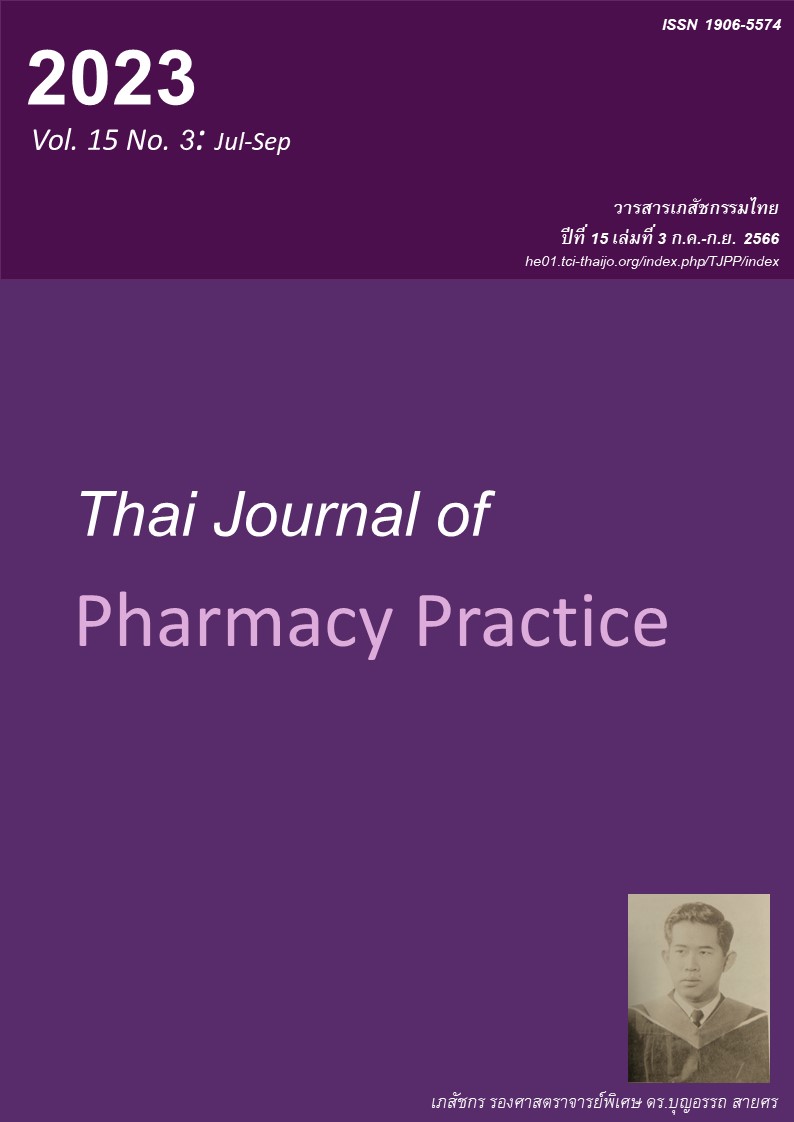รูปแบบการใช้ยา vancomycin และผลของการให้ความรู้และคำแนะนำการใช้ยา vancomycin ต่อแพทย์โดยเภสัชกรในหอผู้ป่วยอายุรกรรมวิกฤต ณ โรงพยาบาลจุฬาลงกรณ์ สภากาชาดไทย
Main Article Content
บทคัดย่อ
วัตถุประสงค์: เพื่อศึกษารูปแบบของการใช้ยา vancomycin และผลของการให้ความรู้และคำแนะนำการใช้ยา vancomycin ต่อแพทย์โดยเภสัชกรในหอผู้ป่วยอายุรกรรมวิกฤต ณ โรงพยาบาลจุฬาลงกรณ์ สภากาชาดไทย วิธีการ: การศึกษานี้เป็นการวิจัยย้อนหลังเชิงพรรณนาเป็นระยะเวลา 12 เดือนในผู้ป่วยอายุตั้งแต่ 18 ปีขี้นไป ที่ได้รับการรักษาด้วยยา vancomycin ที่หอผู้ป่วยอายุรกรรมวิกฤต ณ โรงพยาบาลจุฬาลงกรณ์ สภากาชาดไทย เภสัชกรให้ความรู้เกี่ยวกับการใช้ยา vancomycin แก่แพทย์ประจำหอผู้ป่วยอายุรกรรมวิกฤตในประเด็นขนาดการใช้ยาเริ่มต้นและวิธีการติดตามระดับยาในเลือด รวมถึงติดตามผู้ป่วยที่ได้รับการสั่งใช้ยา vancomycin การศึกษาเก็บข้อมูลทั่วไปของผู้ป่วย รูปแบบการสั่งใช้ยา ระดับยา vancomycin และประเด็นการให้คำแนะนำโดยเภสัชกร เช่น การปรับขนาดยาและการติดตามระดับยาในเลือด รวมถึงร้อยละการยอมรับคำแนะนำจากแพทย์ ผลการวิจัย: งานวิจัยนี้รวบรวมข้อมูลจากผู้ป่วยทั้งหมด 85 ราย (105 ใบสั่งยา) ผู้ป่วยเป็นเพศชายร้อยละ 56.47 อายุเฉลี่ย 66.55 ± 17.44 ปี รูปแบบการใช้ยา vancomycin ในครั้งแรกของการสั่งใช้ยาเป็นการรักษาแบบคาดการณ์ล่วงหน้าร้อยละ 78.10 ผู้ป่วยร้อยละ 51.90 ได้รับยาในขนาดเริ่มต้น 20-35 มก./กก. ระดับยา vancomycin ก่อนให้ยาครั้งถัดไป (Ctrough) อยู่ในช่วง 10-20 มก./ล. ในผู้ป่วยร้อยละ 56.98 หลังจากได้รับการรักษาด้วยยา vancomycin ผู้ป่วยมีระดับซีรัมครีอะตินีนสูงขึ้นแต่ไม่มีนัยสำคัญทางสถิติ (P=0.57) เภสัชกรได้ให้คำแนะนำทั้งหมด 11 ครั้ง และได้รับการยอมรับคำแนะนำทุกครั้ง สรุป: การแนะนำรูปแบบการใช้ยา vancomycin ในขนาดเริ่มต้นที่เหมาะสมโดยเภสัชกร ส่งผลให้ผู้ป่วยมีระดับยา vancomycin ก่อนให้ยาครั้งถัดไป (Ctrough) อยู่ในเป้าหมายที่กำหนดได้
Article Details

อนุญาตภายใต้เงื่อนไข Creative Commons Attribution-NonCommercial-NoDerivatives 4.0 International License.
ผลการวิจัยและความคิดเห็นที่ปรากฏในบทความถือเป็นความคิดเห็นและอยู่ในความรับผิดชอบของผู้นิพนธ์ มิใช่ความเห็นหรือความรับผิดชอบของกองบรรณาธิการ หรือคณะเภสัชศาสตร์ มหาวิทยาลัยสงขลานครินทร์ ทั้งนี้ไม่รวมความผิดพลาดอันเกิดจากการพิมพ์ บทความที่ได้รับการเผยแพร่โดยวารสารเภสัชกรรมไทยถือเป็นสิทธิ์ของวารสารฯ
เอกสารอ้างอิง
Köck R, Becker K, Cookson B, van Gemert-Pijnen J, Harbarth S, Kluytmans J, et al. Methicillin-resistant Staphylococcus aureus (MRSA): burden of disease and control challenges in Europe. Eurosurveillance. 2010; 15: 19688.
Hanberger H, Walther S, Leone M, Barie PS, Rello J, Lipman J, et al. Increased mortality associated with meticillin-resistant Staphylococcus aureus (MRSA) infection in the intensive care unit: Results from the EPIC II study. Int J Antimicrob Agents. 2011; 38: 331-5.
Abdul-Aziz MH, Alffenaar J-WC, Bassetti M, Bracht H, Dimopoulos G, Marriott D, et al. Antimicrobial therapeutic drug monitoring in critically ill adult patients: A position paper. Intensive Care Med. 2020; 46: 1127-53.
Barna J, Williams D. The structure and mode of action of glycopeptide antibiotics of the vancomycin group. Annu Rev Microbiol. 1984; 38: 339-57.
Levine DP. Vancomycin: a history. Clin Infect Dis. 2006; 42(Supplement_1): S5-S12.
Rybak MJ, Le J, Lodise TP, Levine DP, Bradley JS, Liu C, et al. Therapeutic monitoring of vancomycin for serious methicillin-resistant Staphylococcus aureus infections: A revised consensus guideline and review by the American Society of Health-System Pharmacists, the Infectious Diseases Society of America, the Pediatric Infectious Diseases Society, and the Society of Infectious Diseases Pharmacists. Am J Health Syst Pharm 2020; 77: 835-64.
Roberts JA, Lipman J. Pharmacokinetic issues for antibiotics in the critically ill patient. Crit Care Med. 2009; 37: 840-51.
Ye Z-K, Tang H-L, Zhai S-D. Benefits of therapeutic drug monitoring of vancomycin: a systematic review and meta-analysis. PloS one. 2013; 8: e77169.
Hirano R, Sakamoto Y, Kitazawa J, Yamamoto S, Tachibana N. Pharmacist-managed dose adjustment feedback using therapeutic drug monitoring of vancomycin was useful for patients with methicillin-resistant Staphylococcus aureus infections: a single institution experience. Infect Drug Resist. 2016; 9: 243.
Habib G, Lancellotti P, Antunes MJ, Bongiorni MG, Casalta J-P, Del Zotti F, et al. 2015 ESC Guidelines for the management of infective endocarditis: The Task Force for the Management of Infective Endocarditis of the European Society of Cardiology (ESC)Endorsed by: European Association for Cardio-Thoracic Surgery (EACTS), the European Association of Nuclear Medicine (EANM). Eur Heart J. 2015; 36: 3075-128.
Rybak MJ, Lomaestro BM, Rotscahfer JC, Moellering RC, Jr., Craig WA, Billeter M, et al. Vancomycin Therapeutic Guidelines: A Summary of Consensus Recommendations from the Infectious Diseases Society of America, the American Society of Health-System Pharmacists, and the Society of Infectious Diseases Pharmacists. Clin Infect Dis. 2009; 49: 325-7.
Organization WH. Defined Daily Dose (DDD) [online]. 2020 [cited July 8, 2022]. Available from: www.who.int/toolkits/atc-ddd-toolkit/about-ddd.
Morris AM, Brener S, Dresser L, Daneman N, Dellit TH, Avdic E, et al. Use of a structured panel process to define quality metrics for antimicrobial stewardship programs. Infect Control Hosp Epidemiol. 2012; 33: 500-6.
Knaus WA, Draper EA, Wagner DP, Zimmerman JE. APACHE II: a severity of disease classification system. Crit Care Med. 1985; 13: 818-29.
Bone RC, Balk RA, Cerra FB, et al. American College of Chest Physicians/Society of Critical Care
Medicine Consensus Conference: definitions for sepsis and organ failure and guidelines for the use of innovative therapies in sepsis. Crit Care Med 1992; 20: 864-74.
Kaukonen K-M, Bailey M, Pilcher D, Cooper DJ, Bellomo R. Systemic inflammatory response syndrome criteria in defining severe sepsis. N Engl J Med. 2015; 372: 1629-38.
Abdul-Aziz MH, Sulaiman H, Mat-Nor M-B, Rai V, Wong KK, Hasan MS, et al. Beta-Lactam Infusion in Severe Sepsis (BLISS): a prospective, two-centre, open-labelled randomised controlled trial of continuous versus intermittent beta-lactam infusion in critically ill patients with severe sepsis. Intensive Care Med. 2016; 42: 1535-45.
Alshehri N, Ahmed AE, Yenugadhati N, Javad S, Al Sulaiman K, Al-Dorzi HM, et al. Vancomycin in ICU patients with gram-positive infections: Initial trough levels and mortality. Ther Clin Risk Manag. 2020; 16: 979.
Ueda T, Takesue Y, Nakajima K, Ichiki K, Ishikawa K, Takai Y, et al. Vancomycin loading dose is associated with increased early clinical response without attainment of initial target trough concentration at a steady state in patients with methicillin-resistant Staphylococcus aureus infections. J Clin Pharm Ther. 2020; 45: 682-90.
Cotta M, Roberts J, Lipman J. Antibiotic dose optimization in critically ill patients. Med Intensiva. 2015; 39: 563-72.
Truong J, Levkovich B, Padiglione A. Simple approach to improving vancomycin dosing in intensive care: a standardised loading dose results in earlier therapeutic levels. Internal Med J. 2012; 42: 23-9.
Hodiamont C, Juffermans N, Berends S, van Vessem D, Hakkens N, Mathôt R, et al. Impact of a vancomycin loading dose on the achievement of target vancomycin exposure in the first 24 h and on the accompanying risk of nephrotoxicity in critically ill patients. J Antimicrob Chemother. 2021; 76: 2941-9.
DeRyke CA, Alexander DP. Optimizing vancomycin dosing through pharmacodynamic assessment targeting area under the concentration-time curve/minimum inhibitory concentration. Hosp Pharm. 2009; 44: 751-65.


